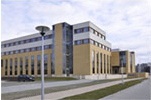1. Global dynamics of asymptotically anti-de Sitter spacetimes
|
Polish supervisor:
|
Piotr Bizoń
|
|
Cooperating partners:
|
Lars Andersson (A. Einstein Institute, Potsdam)
Piotr T. Chru¶ciel (University of Vienna)
Gary Gibbons (University of Cambridge)
|
Asymptotically anti-de Sitter (AdS) spacetimes have come to play
a central role in theoretical physics, prominently due to the
AdS/CFT correspondence which postulates a duality between
supergravity on AdS x M (with M a
compact manifold) and a conformal field theory (CFT) defined on
the boundary I of the AdS bulk. One of the main open
mathematical issues in this context is the problem of nonlinear
stability of the exact AdS spacetime (the maximally symmetric
solution of vacuum Einstein's equations with a negative
cosmological constant Λ<0). Let us recall that the
corresponding stability problems have been solved for Λ=0
(the famous proof of nonlinear stability of Minkowski spacetime by
Christodoulou and Klainerman) and for Λ>0 (proofs of
nonlinear stability of de Sitter spacetime by Friedrich and
Anderson). The key hard feature of AdS (distinguishing it from the
cases with nonnegative Λ) is the presence of the timelike
boundary at spatial infinity, which gives the problem of stability
a flavour of a Hamiltonian conservative system on a bounded domain
and precludes asymptotic stability.
The goal of this project is to study different aspects of
long-time dynamics of solutions of Einstein's equations with
Λ<0 (both in vacuum and with matter fields) under certain
simplifying symmetry assumptions (like spherical symmetry or
cohomogeneity-two Bianchi IX triaxial symmetry). Of course, the
student is not expected to solve the problem of nonlinear
stability of AdS but we hope that his/her studies will shed light
on the problem, in particular will generate a well-substantiated
conjecture. More concretely, the student is expected to work on:
i) the role of different boundary conditions for the fields at
I in the Cauchy evolution, ii) the development of a
numerical code for solving the full system of Einstein-matter
equations (under 1+1 symmetry reduction) with Λ<0 in
various dimensions, iii) the long-time evolution of small
perturbations of AdS, in particular analyze a possibility of
focusing of energy on small spatiotemporal scales, iv) formation
of black holes and their asymptotic stability (due to, so called,
quasinormal ringing) for large perturbations of AdS.
|




|
|



